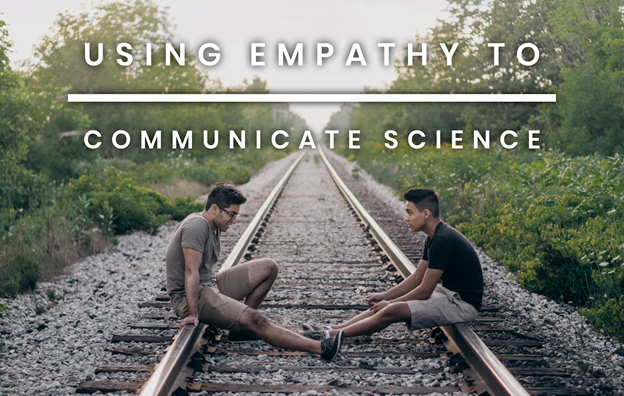What factors would you say are most important for effective science communication?
Factual information? Surely. Clarity? Absolutely. A two-way conversation? Of course...but how do we facilitate one of those in times where supercharged politics have infiltrated every corner of the science realm?
We present: empathy, the key that opens doors that fear has closed.
Empathy is the capacity to not only understand and accept that a person has certain feelings about an issue, but to truly feel what they are experiencing from within their own frame of reference. Simply put, it is to walk a mile in their shoes.
This is vital in science communication. It builds trust between communities and scientists, making room for constructive dialogue. Without it, researchers will continue to be perceived as cold and detached, and will only reinforce the stereotype that scientific advancement is dangerous and, as my good friend likes to say, “a Babylon thing” - in other words, something that pollutes the natural order of things and should never be trusted. Fortunately, she doesn’t say this about science - but there are too many people who do feel this way about scientific topics, whether it be because of religious reasons, fear or a lack of understanding.
When we consider that individuals often value their own and their loved ones’ health above all else, it becomes easier to understand why anything perceived as a threat to their well-being can elicit such strong reactions - like what we see from some anti-vaxxers: parents who are terrified to vaccinate their children lest they end up doing more harm than good. This is when it becomes critical to exercise empathy, however difficult it may be.
Vaccine hesitancy and decision-making are influenced by a number of emotional, cultural, social, spiritual and political factors. Each individual will have a unique combination of these motivating their choices. Because of this, we have to evaluate and approach each person differently and appropriately after carefully considering their perspective.
It’s important to note that this approach also applies to communicating science with audiences who knowingly spread misinformation and attack the scientific community. Applying the principles of empathy will help us understand their motives and determine how to respond most effectively, all while minimizing collateral damage. Sometimes, the most effective approach may be to refuse to engage with them at all, simply focusing on re-educating their audiences, while other times it may be more prudent to deal with them directly, an approach which requires its own tactics and warrants its own article.
Here’s how Sarah Olson, a contributing writer for SciCommPLOS, applies empathy when she shares science with hesitant audiences:
First, she takes time to ask about the person’s concerns, making sure to do so in a polite, non-aggressive way.
“I listen to the hesitant person by politely asking about their concerns. I get to the root of their apprehension or doubts by encouraging them to share their thoughts and feelings. This helps me to recognize their level of literacy on a particular scientific topic,” she says. “Are their fears rooted in a misunderstanding of chemicals? Are their doubts related to unfounded connections between the MMR vaccine and autism? How much education have they had? Where do they usually get their information and news?”
Putting facts in context can be helpful for non-scientific audiences when it comes to connecting the dots, so Sarah seeks to broaden her listener’s perspective. To do this, she shares facts that are directly related to their anxieties. “I understand your concern about the use of formaldehyde in vaccines because it sounds like a scary or harmful chemical [...] but did you know there is more formaldehyde naturally occurring in an infant’s body than the amount present in a vaccine?”
When sharing facts and information with them, she also makes sure to validate their emotions. One of the biggest things to remember when exercising empathy is to practice not using a demeaning or vexed tone of voice. “We have to treat them as though their feelings are valid, even if they are unfounded,” Sarah says.
There are many ways to practice empathy, but the key here is to practice. Each time we apply empathy, the situation will present its own challenges which we will need to take into account and adapt to. Scientists represent the best source of available modern knowledge, but for this information to benefit society and the world in a positive way, we have to be worthy of the public’s trust. And how do we do that? By being empathetic to their needs and concerns.
Perhaps Dr. Vincent Covello, director of the Center for Risk Communication in New York, said it best:
“People don’t care what you know, they want to know that you care.”
References:
- Cormick, C. (2021, April 08). If you want to propound the science, try a little empathy. Retrieved May 20, 2021, from https://cosmosmagazine.com/biology/if-you-want-to-propound-the-science-try-a-little-empathy/
- Noterman, M. (2017). The empathetic scientist. Retrieved May 20, 2021, from https://ir.uiowa.edu/synthesis/vol1/iss1/1/
- Olson, S., & Elvidge, S. (2020, October 30). Communicating vaccine science with empathy. Retrieved May 20, 2021, from https://scicomm.plos.org/2019/11/05/communicating-vaccine-science-with-empathy/

